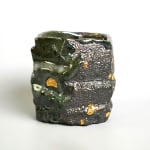Ichikawa Toru 市川 透 Japanese, b. 1973
H12 x Dia 11cm
Further images
-
(View a larger image of thumbnail 1
)

-
(View a larger image of thumbnail 2
)

-
(View a larger image of thumbnail 3
)

-
(View a larger image of thumbnail 4
)

-
(View a larger image of thumbnail 5
)

-
(View a larger image of thumbnail 6
)

-
(View a larger image of thumbnail 7
)

-
(View a larger image of thumbnail 8
)

-
(View a larger image of thumbnail 9
)

-
(View a larger image of thumbnail 10
)

Of the younger generation from Bizen's constellation of innovators, one potter has caught our eye and attention. Ichikawa Toru's work is becoming a phenomenon. This Tokyo-born sculptor studied with one of Bizen's luminaries and learned of its traditions. Ichikawa challenges traditions by blurring the lines between craft and art. Certainly, his work raises some eyebrows!
Ichikawa studied under Kakurezaki Ryuichi 隠崎隆一 (1953- ), and you can see the apprenticeship in his forms, which he takes forward with his daring interventions. A striking example of this is the variety of glazes on Ichikawa's tea bowls. He marries celadon glaze with Bizen clay, and focuses on how glaze expresses color in his sake cups, tea bowls, and bottles... colors usually seen in modern paintings will excite you, shock you, and offer a fresh perspective. Ichikawa presents us with a contemporary image that can be still be held and adored as a ceramic sculpture. Ichikawa Toru’s radical take on Bizen ware showcases his inheritance of Kakurezaki Ryuichi’s bold designs. A young master of modern pottery, he takes Bizen to new heights.
Ichikawa’s glaze bubbles under the heat of the kiln. The temperature suspends this simmering complexion, producing an interesting surface texture consisting of rounded, bulbous protrusions. The artist’s decision to apply a thick glaze may be seen in this piece too: as the glaze drips down from the top of this wheel thrown bowl, the heat of the kiln fixes this drip in place. The resulting glaze drapes over the clay body as though it were a blanket. These techniques affirm the three dimensional tactility of the bowl: it is an object of both art and utility to be felt.









